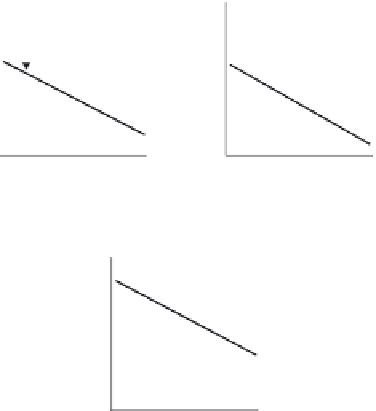Environmental Engineering Reference
In-Depth Information
10.4.3
Arable
farming in the
landscape
While most people are unambiguous in their views about insect pests (get rid of
them!) weeds are another kettle of fi sh. From the point of view of farm productivity
the fewer weeds the better. But when it comes to biodiversity, farming practices that
enhance the richness of noncrop plants (which farmers usually call weeds) have
much to offer. Organically farmed wheat fi elds in Germany, for example, contain a
greater richness of weeds per fi eld (30-66 species) t han conventionally farmed fi elds
where herbicides are used routinely (13-40 species) (Roschewitz et al., 2005). Of
more interest in the context of landscape management, however, is the fi nding that
heterogeneity of land use around the wheat fi elds strongly infl uences the richness
of weeds they contain. More complex landscapes have greater proportions of fi eld
margin, fallow land, grassland and gardens in the 1-km circle surrounding the wheat
fi eld, while simple, homogeneous landscapes have very large proportions of arable
land (around 95%). It turns out that an increase in landscape complexity produces
a greater gain in weed species richness in conventional than organic fi elds, to the
extent that richness (alpha, beta and gamma - see Box 10.1) is similar in both
farming systems when the surrounding landscape is complex (Figure 10.9).
10.5
Restoration
landscapes
Many species use more than a single habitat. So when it comes to reintroducing
species that were formerly common in an area (the vultures in Section 10.5.1), or
modifying patterns of land management to benefi t a species in decline (the hares in
(a)
(b)
80
80
40
40
20
20
10
10
5
20
5
20
40
60
80
100
40
60
80
100
Arable land (%)
Arable land (%)
(c)
80
40
20
10
5
20
40
60
80
100
Arable land (%)
Fig.
10.9
Species richness of weeds in wheat fi elds, grown conventionally (with intensive use of
fertilizers and pesticides - circles and solid lines) or organically (triangles and dashed lines), in
relation to percentage arable land in the area surrounding the fi eld (1 km radius). Wheat fi elds in
the simplest landscapes are surrounded by about 95% arable land. Lower values for percentage
arable land correspond to more complex landscapes with greater proportions of grassland,
gardens, etc. (a) Alpha richness is the average number of weed species in four plots in each fi eld.
(b) Beta richness is the between-plot component of richness. (c) Gamma richness is the total
richness of all four plots combined. (After Roschewitz et al., 2005.)


























































Search WWH ::

Custom Search